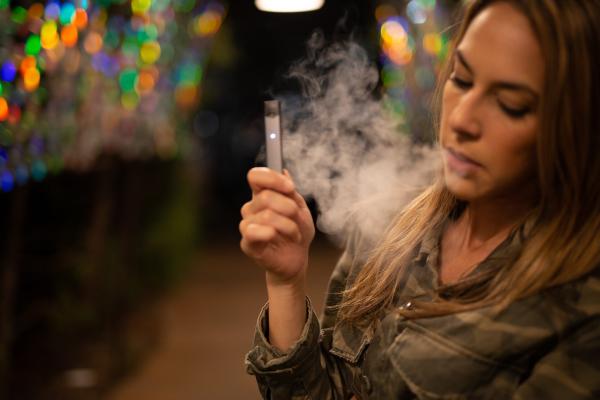If you're a parent, the chances are good that you know at least one other parent who worries about everything: toxic baby food, pesticides, stranger danger, drug use, COVID—you name it, they're worried it's going to kill their children. These examples are all real risks to our kids, but part of developing your parental skills is learning how to properly assess risk and respond to it. [1] In an ideal world, educators would help moms and dads through this arduous process by giving them accurate information.
This is not how the world works, unfortunately. The people we trust to educate our kids and look out for their health and safety often do nothing of the sort. Case in point: the Associated Press put the following headline on a story out this week about teen vaping.

The article itself is only 139 words, yet it's chock-full of unnecessary exaggeration and innuendo from a school district superintendent. While she's undoubtedly sincere, her efforts will do nothing but inflame parents' concerns. We can all agree that teenagers shouldn't be using any nicotine-containing product, but there's a more responsible way to deliver that message. Let's read the AP's sloppy report and then supplement it with important details every parent should know.
"The superintendent of a Mississippi school system is warning parents that vaping with e-cigarettes is becoming a dangerous problem. Hancock County Superintendent Theresa Merwin talked about vaping in her weekly message on school district happenings, The Sun Herald of Biloxi reported. People under 21 cannot vape, so all vaping on school grounds is illegal, Merwin said."
Merwin told the newspaper a few students have needed medical attention after vaping. 'This has to stop now before a fatality happens,' the superintendent said in her video. Any students caught vaping will face expulsion and if the cartridge inside the e-cigarette contains an illegal substance, police will be called, Merwin said.
I watched Merwin's video. She correctly distinguished between vaping products that contain nicotine and those designed for THC (the major psychoactive compound in cannabis), warning teenagers that they may be exposed to a potentially deadly substance when they use a device they think contains only nicotine. That's true enough, as my colleague Dr. Josh Bloom wrote in 2019,
it is likely that the lung damage is caused not by manufactured e-cigarettes, but rather, vaping devices which have been loaded with marijuana chemicals or other normally-harmless chemicals, like vitamin E acetate.
But Merwin quickly went off the rails after this, lumping all these vaping devices into the same amorphous category. “Vaping is not better than smoking, she continued, “...this has to stop now before a fatality happens.” The implication in the AP report and video is that all these products pose a high risk to all children.
This is false for two reasons.
Vaping nicotine is a low-risk activity relative to smoking tobacco. In fact, e-cigarettes “are estimated to be only a fraction as harmful as conventional cigarettes,” the authors of a January 2021 study noted. They added that teenagers who vape tend to be smokers who are trying to quick cigarettes:
"Not only does the current study demonstrate that actual data are much more consistent with a diversion effect than a catalyst effect, but the magnitude of this effect is somewhat large, even using conservative assumptions. This is consistent with other recent research showing that declines in cigarette use have accelerated after the introduction of ECs."
This analysis changes the discussion entirely. First, and most importantly, it suggests that teenage vapers have substantially reduced the risk they face by displacing some or all of their cigarette consumption. As I said above, no minor should vape or smoke, though parents need to know that these products are very different.
By way of analogy, I want to know if my son's baby food could expose him to heavy metals, but I don't want crusading members of Congress to exaggerate that risk to bolster their reelection efforts. Tell me about the real threats I face, don't needlessly scare me. Exaggerations are just as misleading as understatements in this context.
The study also suggests that parents need to find out why their kids started smoking cigarettes in the first place. Was it stress or anxiety, perhaps induced by the hellish two years we've just been through? Or maybe these teens were driven to smoking by an undiagnosed mental disorder? This is quite common in people suffering from depression, for example. Whatever the case may be, asking a student why they're switching from a very harmful product to a less risky alternative is the wrong place to start the dialogue.
Finally, if vaping primarily attracts teenagers who already consume tobacco, parents should be informed that most minors are not interested in e-cigarettes. This isn't to dismiss the reality that some teenagers use nicotine, but simply to remind everybody that many adolescent health issues are worth our attention.
Sexually transmitted infections are still very common, and more than half of all reported cases in 2019 occurred in the 15-24 age range. [2] Mental health disorders pose an equally troubling threat; just under three million children aged 3-17 years were diagnosed with depression between 2016 and 2019.
We all agree: vaping is an activity for adults; the fewer children who consume nicotine, the healthier society will be. That said, exaggeration helps no one. Let's redirect some of our energy to more productive causes.
[1] I'm still not great at this, but I'm getting better. It's a process.
[2] Those are the most recent data reported by the CDC.




